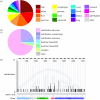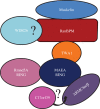Cell signalling pathway regulation by RanBPM: molecular insights and disease implications
- PMID: 28659384
- PMCID: PMC5493780
- DOI: 10.1098/rsob.170081
Cell signalling pathway regulation by RanBPM: molecular insights and disease implications
Abstract
RanBPM (Ran-binding protein M, also called RanBP9) is an evolutionarily conserved, ubiquitous protein which localizes to both nucleus and cytoplasm. RanBPM has been implicated in the regulation of a number of signalling pathways to regulate several cellular processes such as apoptosis, cell adhesion, migration as well as transcription, and plays a critical role during development. In addition, RanBPM has been shown to regulate pathways implicated in cancer and Alzheimer's disease, implying that RanBPM has important functions in both normal and pathological development. While its functions in these processes are still poorly understood, RanBPM has been identified as a component of a large complex, termed the CTLH (C-terminal to LisH) complex. The yeast homologue of this complex functions as an E3 ubiquitin ligase that targets enzymes of the gluconeogenesis pathway. While the CTLH complex E3 ubiquitin ligase activity and substrates still remain to be characterized, the high level of conservation between the complexes in yeast and mammals infers that the CTLH complex could also serve to promote the degradation of specific substrates through ubiquitination, therefore suggesting the possibility that RanBPM's various functions may be mediated through the activity of the CTLH complex.
Keywords: Alzheimer disease; CTLH complex; Gid; RanBPM; cancer.
© 2017 The Authors.
Conflict of interest statement
We declare we have no competing interests.
Figures



Similar articles
-
Interactions of an Arabidopsis RanBPM homologue with LisH-CTLH domain proteins revealed high conservation of CTLH complexes in eukaryotes.BMC Plant Biol. 2012 Jun 7;12:83. doi: 10.1186/1471-2229-12-83. BMC Plant Biol. 2012. PMID: 22676313 Free PMC article.
-
Inhibition of HDAC6 activity through interaction with RanBPM and its associated CTLH complex.BMC Cancer. 2017 Jul 1;17(1):460. doi: 10.1186/s12885-017-3430-2. BMC Cancer. 2017. PMID: 28668087 Free PMC article.
-
Molecular phylogeny of a RING E3 ubiquitin ligase, conserved in eukaryotic cells and dominated by homologous components, the muskelin/RanBPM/CTLH complex.PLoS One. 2013 Oct 15;8(10):e75217. doi: 10.1371/journal.pone.0075217. eCollection 2013. PLoS One. 2013. PMID: 24143168 Free PMC article.
-
Diverse roles of the scaffolding protein RanBPM.Drug Discov Today. 2012 Apr;17(7-8):379-87. doi: 10.1016/j.drudis.2011.10.030. Epub 2011 Nov 7. Drug Discov Today. 2012. PMID: 22094242 Review.
-
Scaffolding protein RanBPM and its interactions in diverse signaling pathways in health and disease.Discov Med. 2018 Apr;25(138):177-194. Discov Med. 2018. PMID: 29723489 Review.
Cited by
-
S100A7/Ran-binding protein 9 coevolution in mammals.Immunogenetics. 2020 Apr;72(3):155-164. doi: 10.1007/s00251-020-01155-9. Epub 2020 Feb 10. Immunogenetics. 2020. PMID: 32043173
-
A GID E3 ligase assembly ubiquitinates an Rsp5 E3 adaptor and regulates plasma membrane transporters.EMBO Rep. 2022 Jun 7;23(6):e53835. doi: 10.15252/embr.202153835. Epub 2022 Apr 19. EMBO Rep. 2022. PMID: 35437932 Free PMC article.
-
Proteomic analysis of ubiquitination substrates reveals a CTLH E3 ligase complex-dependent regulation of glycolysis.FASEB J. 2021 Sep;35(9):e21825. doi: 10.1096/fj.202100664R. FASEB J. 2021. PMID: 34383978 Free PMC article.
-
Human cytomegalovirus interactome analysis identifies degradation hubs, domain associations and viral protein functions.Elife. 2019 Dec 24;8:e49894. doi: 10.7554/eLife.49894. Elife. 2019. PMID: 31873071 Free PMC article.
-
RANBP9 affects cancer cells response to genotoxic stress and its overexpression is associated with worse response to platinum in NSCLC patients.Oncogene. 2018 Dec;37(50):6463-6476. doi: 10.1038/s41388-018-0424-8. Epub 2018 Aug 3. Oncogene. 2018. PMID: 30076413 Free PMC article.
References
-
- Nakamura M, et al. 1998. When overexpressed, a novel centrosomal protein, RanBPM, causes ectopic microtubule nucleation similar to gamma-tubulin. J. Cell Biol. 143, 1041–1052. (doi:10.1083/jcb.143.4.1041) - DOI - PMC - PubMed
-
- Nishitani H, Hirose E, Uchimura Y, Nakamura M, Umeda M, Nishii K, Mori N, Nishimoto T. 2001. Full-sized RanBPM cDNA encodes a protein possessing a long stretch of proline and glutamine within the N-terminal region, comprising a large protein complex. Gene 272, 25–33. (doi:10.1016/S0378-1119(01)00553-4) - DOI - PubMed
-
- Santt O, Pfirrmann T, Braun B, Juretschke J, Kimmig P, Scheel H, Hofmann K, Thumm M, Wolf DH. 2008. The yeast GID complex, a novel ubiquitin ligase (E3) involved in the regulation of carbohydrate metabolism. Mol. Biol. Cell 19, 3323–3333. (doi:10.1091/mbc.E08-03-0328) - DOI - PMC - PubMed
-
- Salemi LM, Loureiro SO, Schild-Poulter C. 2015. Characterization of RanBPM molecular determinants that control its subcellular localization. PLoS ONE 10, e0117655 (doi:10.1371/journal.pone.0117655) - DOI - PMC - PubMed
-
- Atabakhsh E, Bryce DM, Lefebvre KJ, Schild-Poulter C. 2009. RanBPM has proapoptotic activities that regulate cell death pathways in response to DNA damage. Mol. Cancer Res. 7, 1962–1972. (doi:10.1158/1541-7786.MCR-09-0098) - DOI - PubMed
Publication types
MeSH terms
Substances
Grants and funding
LinkOut - more resources
Full Text Sources
Other Literature Sources
Miscellaneous

